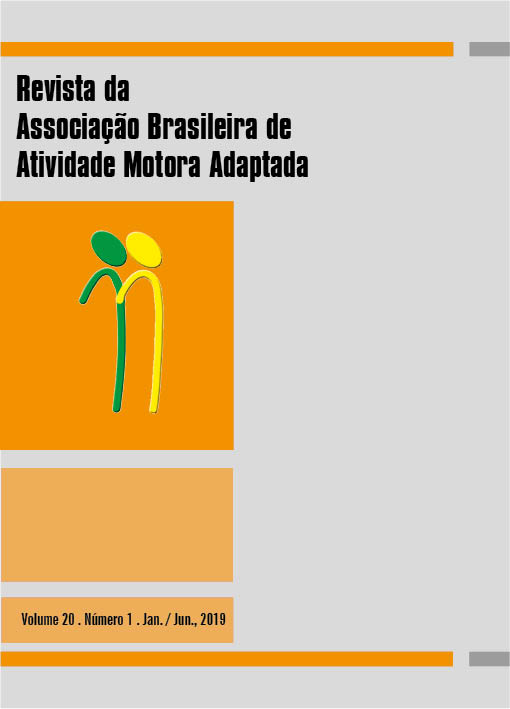THE EFFECTS OF EARLY MOBILIZATION ON INTENSIVE CARE UNITS
DOI:
https://doi.org/10.36311/2674-8681.2019.v20n1.06.p61Keywords:
Early mobilization, Intensive Care Unit, Critical Patients, Adapted Motor ActivityAbstract
The development of generalized weakness related to the critical patient is one of the recurrent complications in an intensive care unit. Reduced muscle strength increases weaning time, hospitalization, risk of infection. Physiotherapy is fundamental in these patients as a resource for prevention of muscle weakness, hypotrophy and recovery of functional capacity. The critical patient admitted to the ICU has severe motor restrictions. Adequate bed positioning and early patient mobilization may represent one of the only possibilities for individual interaction with the environment and should be considered as a source of sensory motor stimulation and prevention of complications secondary to immobility. Some studies address the role of kinesiotherapy in critically ill patients, who in the initial phase are seen as “very sick” or “very clinically unstable” for mobilization interventions. However, early mobilization activities demonstrate benefits. Delaying the beginning of the exercises only helps to intensify the patient’s functional deficit. The objective of this study is to review the literature related to the effects of kinesiotherapy in patients admitted to intensive care units.
Received on: 03/03/2019
Reformulated on: 06/30/2019
Approved on: 06/30/2019
Downloads
References
02. Vanessa Borges, Luiz de Oliveira, Elzio Peixoto, Nilza Carvalho. Fisioterapia motora em pacientes adultos em terapia intensiva. Revista Brasileira de Terapia Intensiva. 2009;21(4):446-452.
03. The TEAM study Investigators Critical Care (2015) 19:81. DOI 10.1186s13054-015-0765-4.
04. Bruno Martinez, Amanda Bispo, Antônio Duarte, Mansueto Neto. Declínio Funcional em uma unidade de terapia intensiva (UTI). Revista Inspirar movimento e saúde. Vol.05. Nº 01, Ed.23. Mar/Abril 2013.
05. Eduardo França, Francimar Ferrari, Patrícia Fernandes, Renata Cavalcante, Antonio Duarte, Bruno Martinez, Esperidião Aquim, Marta Damasceno. Fisioterapia em pacientes críticos adultos: recomendações do Departamento de Fisioterapia da Associação de Medicina Intensiva Brasileira. Revista Brasileira de Terapia Intensiva. Vol.04 nº 01/ Mar.2012
06. Pawlik, AJ< Esbrook, CL, Schweickert, WD, Pohlman, MC, Pohlman, AS, Nigos, C, et al. A randomized trial of early physical and occupational therapy in the management of critically ill patients undergoing mechanical ventilation. Am. J. Respir. Crit. Care Med. 2008
07. Efficacy and safety of very early mobilization within 24h of stroke onset (AVERT): a a randomized controlled trial. Thelancet.Vol 386. Jul/2015.
08. Diane Clarck, John Lowman, Helen Mathethews, Donald Reiff. Effectiveness of an Early Mobilization Protocol In a Trauma and Burns Intensive Care Unit: A Retrospective Cohort Study. Phis Ther. 2013 Feb;93(2): 186-196.
09. Gosselink R, Bott J, Johnson M, Dean E, Nava S, Norrenberg M, et al. Physiotherapy for adult patients with critical illness: recommendations of the European Respiratory Society and European Society of Intensive Care Medicine Task Force on Physiotherapy for Critically Ill Patients. Intensive Care Med. 2008;34(7):88-99
10. Korupolu R, Gifford JM, Needham DM. Early mobilization of critically ill patients: reducing neuromuscular complications after intensive care. Contemp Crit Care. 2009;6(9):1-11.
11. Stiller K, Phillips A. Safety aspects of mobilising acutely ill in patients. Physiother Theory Pract. 2007;19(4):239-57.
12. GUTIS: guia da UTI segura.Réa-Neto, Álvaro; Castro, José Eduardo couto de; Knibel, Marcos Freitas.
São Paulo; Associação de Medicina Intensiva Brasileira; 2010. 22 p.
13. Emtner M, Porszasz J, Burns M, Somfay A, Casaburi R. Benefits of supplemental oxygen in exercise training in nonhypoxemic chronic obstructive pulmonary disease patients. Am J Respir Crit Care Med.;168(9):1034-42.
14. van't Hul A, Gosselink R, Hollander P, Postmus P, Kwakkel G. Training with inspiratory pressure support in patients with severe COPD. Eur Respir J. 2007;27(1):65-72.
15. Borghi-Silva A, Sampaio LMM, Toledo A, Pincelli MP, Costa D. Efeitos agudos da aplicação do BiPAP sobre a tolerância ao exercício físico em pacientes com doença pulmonar obstrutiva crônica (DPOC). Rev Bras Fisioter. 9(3):273-80.
16. Geddes EL, Reid WD, Crowe J, O'Brien K, Brooks D. Inspiratory muscle training in adults with chronic obstructive pulmonary disease: a systematic review. Respir Med. 99(11):1440-58. Review.
17. Gosselink R, Bott J, Johnson M, Dean E, Nava S, Norrenberg M, et al. Physiotherapy for adult patients with critical illness: recommendations of the European Respiratory Society and European Society of Intensive Care Medicine Task Force on Physiotherapy for Critically Ill Patients. Intensive Care Med. 2008;34(7):1188-99.
18. Morris PE. Moving our critically ill patients: mobility barriers and benefits. Crit Care Clin. 2007;23(1):1-20 / 2. Morris PE, Goad A, Thompson C, Taylor K, Harry B, Passmore L, et al. Early intensive care unit mobility therapy in treatment of acute respiratory failure. Crit Care Med. 2008;36(8):2238-432. Morris PE, Goad A, Thompson C, Taylor K, Harry B, Passmore L, et al. Early intensive care unit mobility therapy in treatment of acute respiratory failure. Crit Care Med. 2008;36(8):2238-43
19. Clavet H, Hébert PC, Fergusson D, Doucette S, Trudel G. Joint contracture following prolonged stay in the intensive care unit. CMAJ. 2008;178(6):691-7.
20. Ntoumenopoulos G, Presneill JJ, McElholum M, Cade JF. Chest physiotherapy for the prevention of ventilator-associated pneumonia. Intensive Care Med.28(7):850-6.
21. Griffiths RD, Palmer TE, Helliwell T, MacLennan P, MacMillan RR. Effect of passive stretching on the wasting of muscle in the critically ill. Nutrition. 11(5):428-32.
22. Bailey P, Thomsen GE, Spuhler VJ, Blair R, Jewkes J, Bezdjian L, et al. Early activity is feasible and safe in respiratory failure patients. Crit Care Med. 2007;35(1):139-45.




